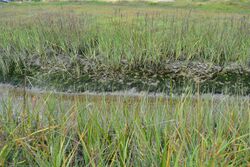Biology:Spartina foliosa
| Spartina foliosa | |
|---|---|

| |
| Scientific classification | |
| Kingdom: | Plantae
|
| (unranked): | |
| (unranked): | Monocots
|
| (unranked): | |
| Order: | |
| Family: | |
| Genus: | Spartina
|
| Species: | S. foliosa
|
| Binomial name | |
| Spartina foliosa Trin.
| |
Spartina foliosa is a species of grass known by the common name California cordgrass.[1] It has been reclassified as Sporobolus foliosus after a taxonomic revision in 2014[2], but Spartina foliosa is still in common usage. It is native to the salt marshes and mudflats of coastal California and Baja California, especially San Francisco Bay. It is a perennial grass growing from short rhizomes. It produces single stems or clumps of thick, fleshy stems that grow up to 1.5 meters tall. They are green or purple-tinged. The long, narrow leaves are flat or rolled inward. The inflorescence is a narrow, dense, spike-like stick of branches appressed together, the unit reaching up to 25 centimeters long. The lower spikelets are sometimes enclosed in the basal sheaths of upper leaves.
This native plant is seriously threatened by the invasion of its North American Atlantic coast relative smooth cordgrass (Spartina alterniflora), which is not native to the Pacific coast. S. alterniflora was introduced to San Francisco Bay in the 1970s and it quickly began to hybridize with S. foliosa. Hybrids generally outcompete the native plant and spread rapidly, threatening S. foliosa with localized extirpation.[3] The two species reproduce at the same time of year, and the invader sheds large amounts of pollen that fertilize the flowers of the native, so that the majority of an affected native plant's offspring are hybrids.[3] This is an example of genetic pollution.[4] S. alterniflora × foliosa hybrids have spread rapidly because they are much more genetically fit than either parental species, an example of hybrid vigor.[5] However, S. foliosa is still the dominant plant at lower tidal elevations in most salt marshes around San Francisco Bay[6], and numerous locations within the Bay have remained uninfested during ongoing efforts to eradicate S. alterniflora and hybrids. Restoration of tidal marsh habitat is in progress at multiple sites, including the planting of cultivated S. foliosa harvested from uninfested locations and propagated in a nursery.[7][8]
References
- ↑ "Spartina foliosa". Natural Resources Conservation Service PLANTS Database. USDA. https://plants.usda.gov/core/profile?symbol=SPFO. Retrieved 24 November 2015.
- ↑ Peterson, PM , et al (2014) A molecular phylogeny and new subgeneric classification of Sporobolus (Poaceae: Chloridoideae: Sporobolinae), Taxon 63: 1212-1243.
- ↑ 3.0 3.1 Ayres, D. R., et al. (2004). Extinction of a common native species by hybridization with an invasive congener. Weed Technology 18 1288-91.
- ↑ Anttila, C. K. et al. (1998). Greater male fitness of a rare invader (Spartina alterniflora, Poaceae) threatens a common native (Spartina foliosa) with hybridization. Am J Bot 85:1597-1601.
- ↑ Spartina foliosa. NatureServe. 2012.
- ↑ Ort, B.O. & Thornton, W.J. (2016) Changes in the population genetics of an invasive Spartina after 10 years of management, Biol. Invasions 18: 2267-2281.
- ↑ Kerr et al (2016) A review of 15 years of Spartina management in the San Francisco Estuary, Biol. Invasions 18: 2247-2266.
- ↑ http://spartina.org/documents/2014_5RevegRpt2015_16Plan_20160126_ALLWeb.pdf, Hammond J, San Francisco Estuary Invasive Spartina Project Revegetation Program Year 4 (2014-2015) Installation Report and Year 5 (2015-2016) Revegetation Plan (DRAFT). Accessed 7/12/18.
External links
- Calflora: Spartina foliosa (California cord grass)
- Jepson Manual (TJM2) Treatment
- USDA Plants Profile for Spartina foliosa (California cordgrass)
- San Francisco Estuary Invasive Spartina Project
- Grass Manual Treatment: Spartina foliosa
- UC CalPhotos gallery
Wikidata ☰ Q7573950 entry


